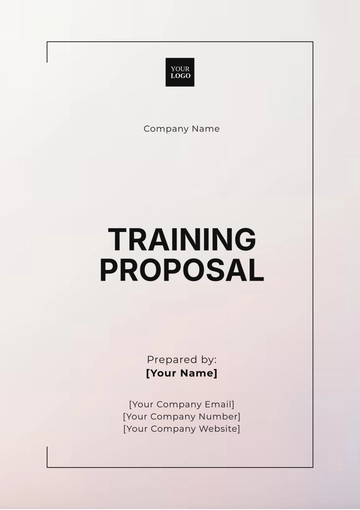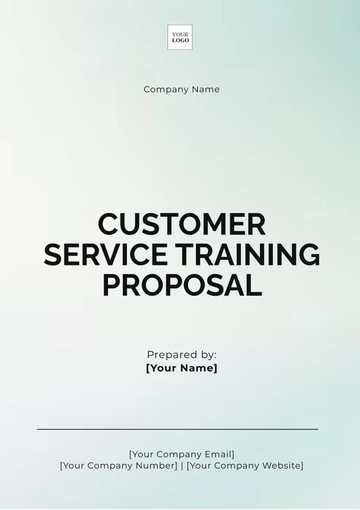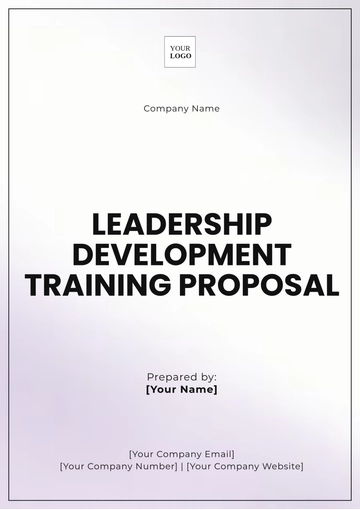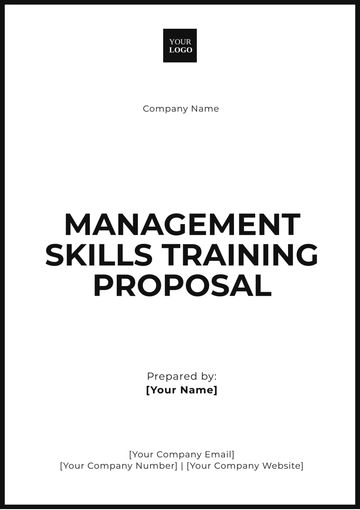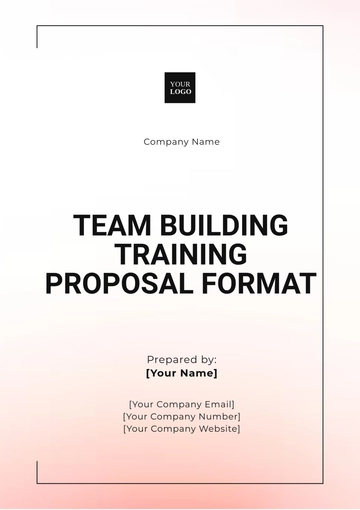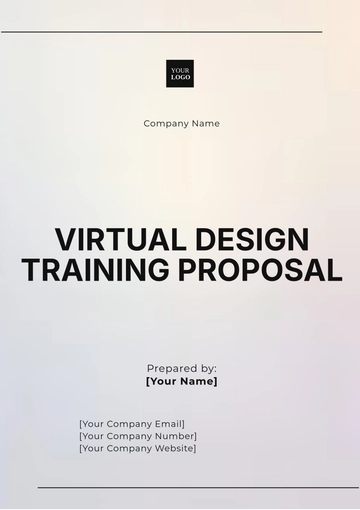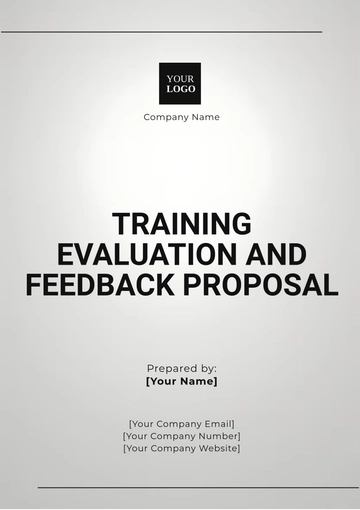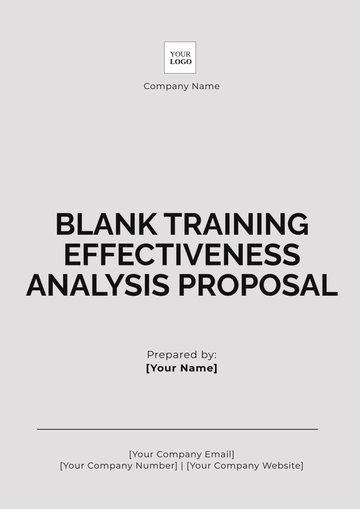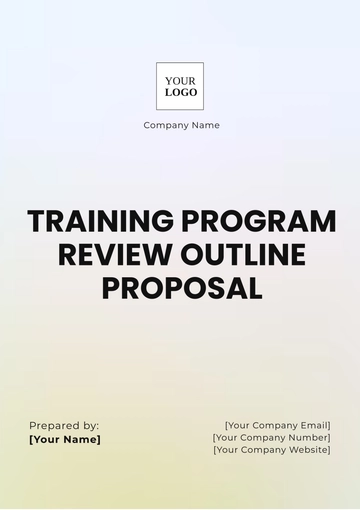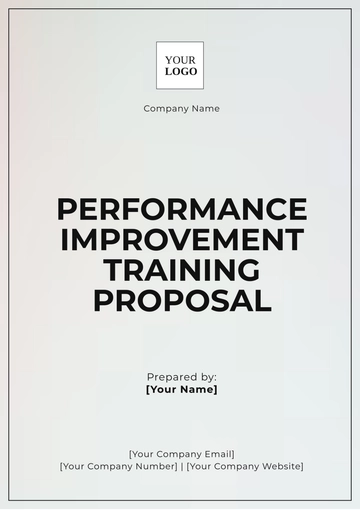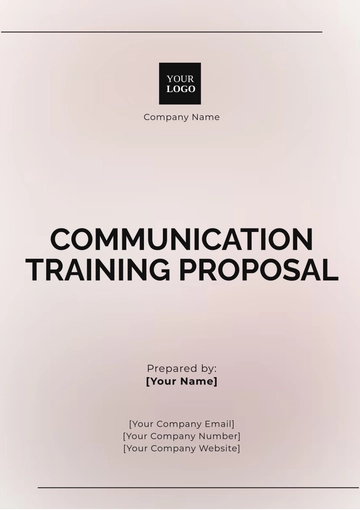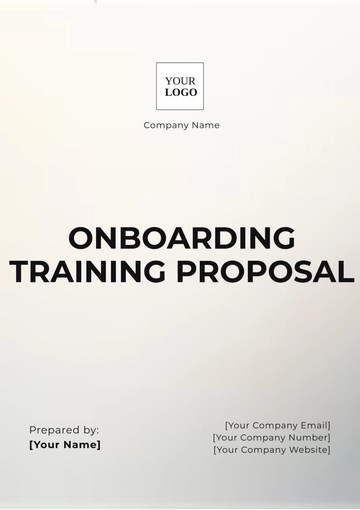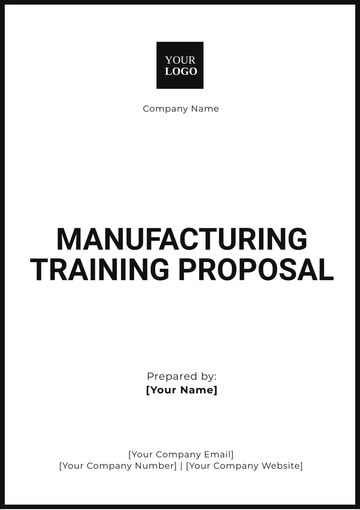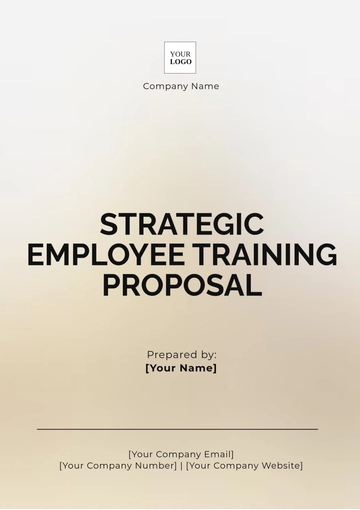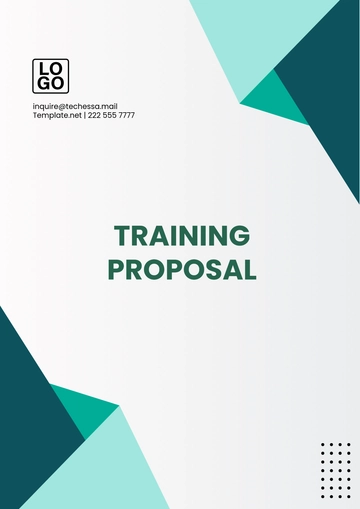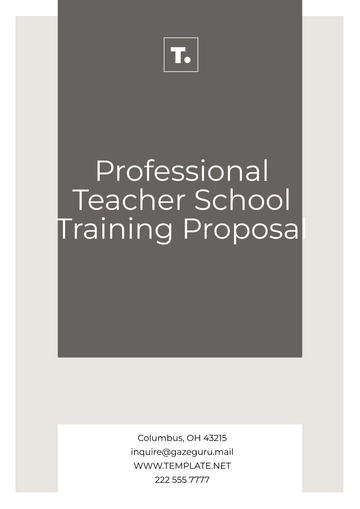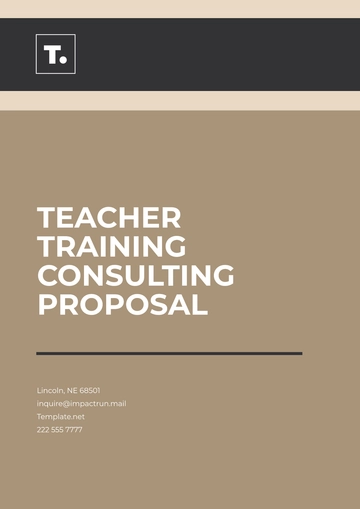Free Corporate Training Proposal Report
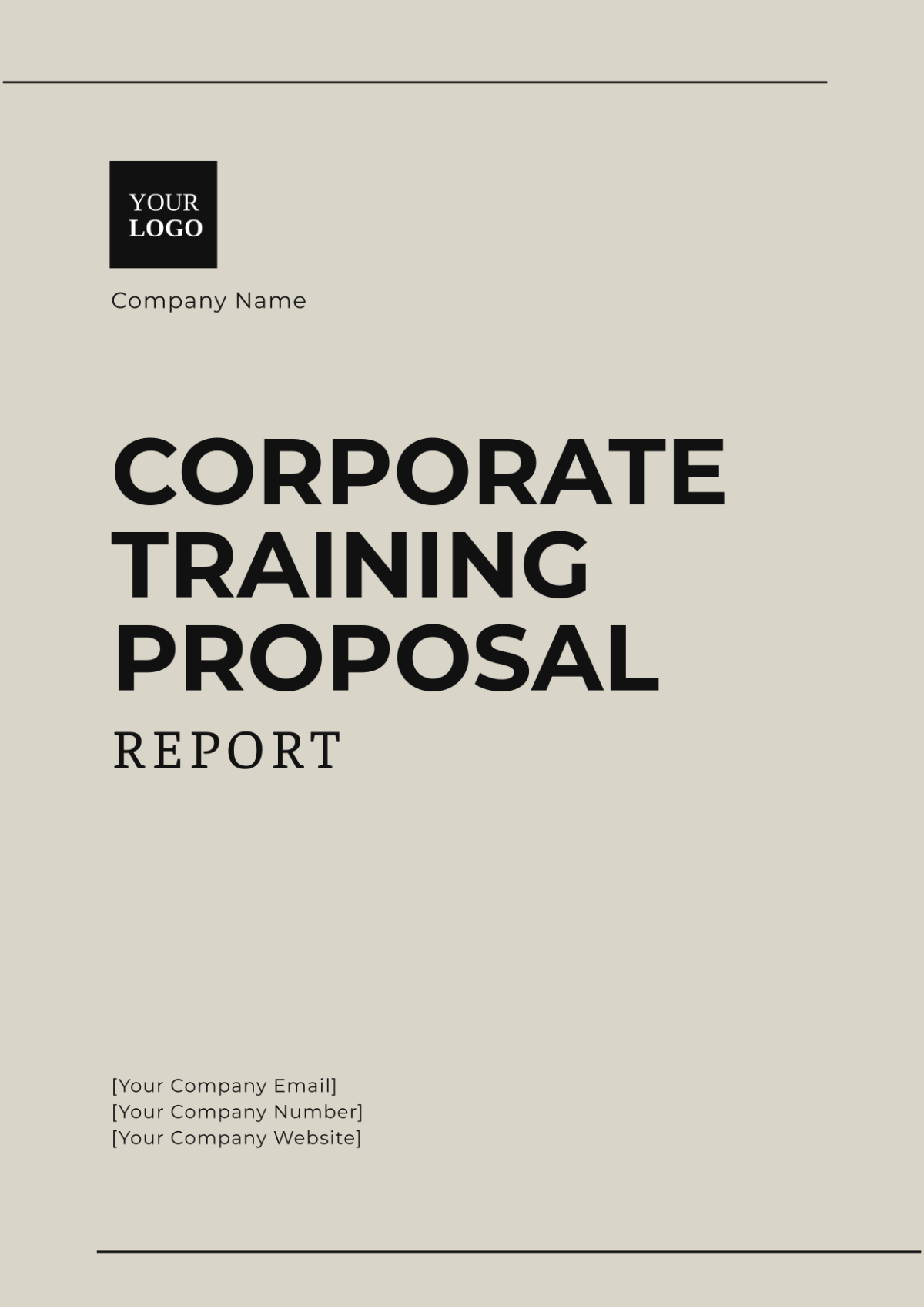
1. Introduction
The purpose of this report is to detail a planned training program designed to enhance the skills and knowledge of employees within the organization. This document outlines the training objectives, methods, curriculum, implementation strategies, budget, and evaluation methods to ensure a successful training initiative.
2. Training Objectives
The primary objectives of the training program are:
Skill Development: Enhance the specific skills required for employees to perform their roles effectively.
Knowledge Expansion: Update and expand employees’ knowledge base in line with industry standards and organizational needs.
Performance Improvement: Improve overall job performance and productivity.
Employee Engagement: Increase employee engagement and satisfaction through professional development opportunities.
3. Training Methods
3.1. Instructional Methods
Classroom Training: Traditional face-to-face training sessions conducted by experienced instructors.
Online Learning: Web-based modules and e-learning platforms for flexible access.
Workshops and Seminars: Interactive sessions focusing on specific skills or topics.
On-the-Job Training: Practical training conducted in the workplace with real-time guidance.
3.2. Delivery Formats
Live Sessions: Real-time virtual or in-person training events.
Recorded Sessions: Pre-recorded training materials are accessible at any time.
Blended Learning: A combination of online and face-to-face training methods.
4. Training Curriculum
4.1. Overview
The training curriculum is designed to address key areas relevant to the organization's needs. The curriculum will be structured into modules, each targeting specific skills or knowledge areas.
4.2. Modules
Module Title | Description | Duration | Delivery Method |
|---|---|---|---|
Introduction to Company | Overview of company history, values, and goals | 2 hours | Classroom/Online |
Technical Skills Training | In-depth training on specific technical skills required | 5 hours | Blended Learning |
Leadership Development | Skills for effective leadership and management | 4 hours | Workshops/Seminars |
Communication Skills | Enhancing verbal and written communication abilities | 3 hours | Online/Blended Learning |
Compliance and Safety | Training on compliance regulations and safety protocols | 2 hours | Recorded/Online |
5. Implementation Strategies
5.1. Planning and Scheduling
Training Calendar: Develop a detailed training calendar outlining all training sessions and deadlines.
Resource Allocation: Assign necessary resources, including trainers, materials, and facilities.
5.2. Trainer Selection
Internal Trainers: Identify and train internal employees who have the expertise to deliver training.
External Trainers: Engage with external experts and consultants when specialized knowledge is required.
5.3. Communication
Announcements: Notify employees about training sessions and requirements through internal communication channels.
Reminders: Send regular reminders to ensure attendance and preparedness.
5.4. Support Materials
Handouts and Guides: Provide participants with relevant handouts, guides, and additional resources.
Access to Online Resources: Ensure all participants have access to online training platforms and materials.
6. Budget
Expense Category | Estimated Cost |
|---|---|
Trainer Fees | $5,000 |
Training Materials | $2,000 |
E-learning Platform | $3,000 |
Venue Rental (if applicable) | $1,500 |
Miscellaneous Expenses | $1,000 |
Total Estimated Budget | $12,500 |
7. Evaluation Methods
7.1. Feedback Collection
Surveys: Distribute post-training surveys to collect feedback on the training content and delivery.
Interviews: Conduct one-on-one interviews with participants to gain deeper insights.
7.2. Performance Metrics
Pre- and Post-Training Assessments: Measure knowledge and skills before and after training to evaluate improvements.
Performance Reviews: Monitor employee performance and productivity to assess the impact of training.
7.3. Continuous Improvement
Review and Revise: Regularly review training outcomes and make necessary adjustments to improve effectiveness.
Best Practices: Incorporate feedback and lessons learned to enhance future training programs.
8. Conclusion
The planned training program is designed to address key areas of development for employees and improve overall organizational performance. Through a combination of effective training methods, a well-structured curriculum, and thorough evaluation, the program aims to achieve its objectives and support the growth of both employees and the organization.
The successful implementation of this training program will depend on careful planning, effective communication, and ongoing evaluation to ensure it meets the evolving needs of the organization.
- 100% Customizable, free editor
- Access 1 Million+ Templates, photo’s & graphics
- Download or share as a template
- Click and replace photos, graphics, text, backgrounds
- Resize, crop, AI write & more
- Access advanced editor
Introducing the Corporate Training Proposal Report Template from Template.net. This fully customizable template is perfect for crafting detailed training proposals. With its easy-to-use format, it's editable in our AI Editor too, ensuring a seamless experience. Tailor each section to your needs, making your proposals standout with professional, polished presentations.
You may also like
- Business Proposal
- Research Proposal
- Proposal Request
- Project Proposal
- Grant Proposal
- Photography Proposal
- Job Proposal
- Budget Proposal
- Marketing Proposal
- Branding Proposal
- Advertising Proposal
- Sales Proposal
- Startup Proposal
- Event Proposal
- Creative Proposal
- Restaurant Proposal
- Blank Proposal
- One Page Proposal
- Proposal Report
- IT Proposal
- Non Profit Proposal
- Training Proposal
- Construction Proposal
- School Proposal
- Cleaning Proposal
- Contract Proposal
- HR Proposal
- Travel Agency Proposal
- Small Business Proposal
- Investment Proposal
- Bid Proposal
- Retail Business Proposal
- Sponsorship Proposal
- Academic Proposal
- Partnership Proposal
- Work Proposal
- Agency Proposal
- University Proposal
- Accounting Proposal
- Real Estate Proposal
- Hotel Proposal
- Product Proposal
- Advertising Agency Proposal
- Development Proposal
- Loan Proposal
- Website Proposal
- Nursing Home Proposal
- Financial Proposal
- Salon Proposal
- Freelancer Proposal
- Funding Proposal
- Work from Home Proposal
- Company Proposal
- Consulting Proposal
- Educational Proposal
- Construction Bid Proposal
- Interior Design Proposal
- New Product Proposal
- Sports Proposal
- Corporate Proposal
- Food Proposal
- Property Proposal
- Maintenance Proposal
- Purchase Proposal
- Rental Proposal
- Recruitment Proposal
- Social Media Proposal
- Travel Proposal
- Trip Proposal
- Software Proposal
- Conference Proposal
- Graphic Design Proposal
- Law Firm Proposal
- Medical Proposal
- Music Proposal
- Pricing Proposal
- SEO Proposal
- Strategy Proposal
- Technical Proposal
- Coaching Proposal
- Ecommerce Proposal
- Fundraising Proposal
- Landscaping Proposal
- Charity Proposal
- Contractor Proposal
- Exhibition Proposal
- Art Proposal
- Mobile Proposal
- Equipment Proposal
- Student Proposal
- Engineering Proposal
- Business Proposal
